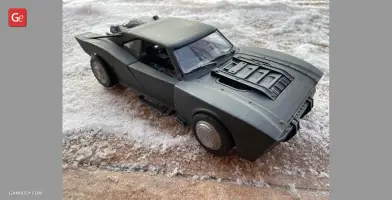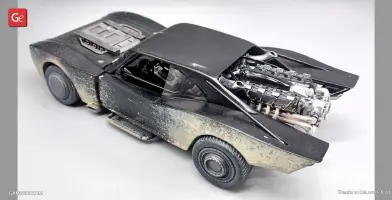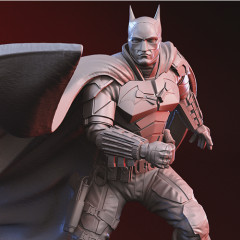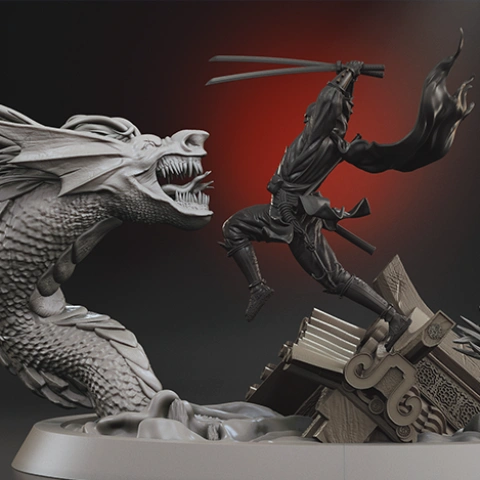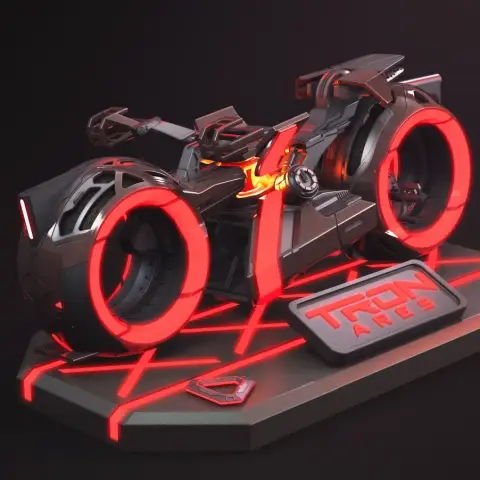Files
3D model format
Stereolithography (.stl)
Total files
Slicer settings
not available
Mesh error check
not specified
Support
Lifetime support from Gambody team
Update requests
not specified
Model versions
FFF/FDM
Assembly method
not specified
Features
DLP/SLA
Assembly method
not specified
Features
Additional details
Part of diorama
No
Special pack included
No
You will get instant access to the STL files of Batmobile 2022 3D Printing Model | Assembly + Active after completing your purchase. Simply add the model to your cart and check out using PayPal, credit or debit card, Apple Pay, Google Pay, Alipay, or other available payment methods.
Watch the assembly video for Batmobile 2022 3D Printing Model | Assembly + Active, and explore more tutorials, behind-the-scenes content, 3D printing timelapses, and painting guides on the official Gambody YouTube channel.
This 3D Model of DC Batmobile 2022 from The Batman consists of files in StereoLithography (.Stl) format that is optimized for 3D printing.
Before printing the files, we strongly recommend reading the PRINTING DETAILS section.
WHAT WILL YOU GET AFTER PURCHASE?
- 2 versions of new Batman car STL files for FFF/FDM and DLP/SLA - files for all versions are available for download after the purchase
- STL files of high-poly 2022 Batmobile 3D Model for 3D printing consist of 128 parts
- Sizes:
FFF/FDM: 79 mm tall, 156 mm wide, 313 mm deep
DLP/SLA: 40 mm tall, 78 mm wide, 156 mm deep
- Assembly Manual for FFF/FDM 1.0 and DLP/SLA 1.0 versions in PDF format
- Detailed settings that we provide as a recommendation for Cura, Simplify3D, Slic3r and PrusaSlicer for the best print
- Full technical support from the Gambody Support Team
Detailed information about this 3D printing model is available in the DESCRIPTION section.
Before printing, take a look at Printing Details for recommended settings and tips to achieve better results.
ABOUT THIS 3D MODEL
The world-renowned vigilante came back on the big screens in the recent instalment, The Batman (2022), and enticed the fans with the brand new design of the Batmobile. Unlike Tim Burton's expressionistic Batmobile, the new urban machine reflects its owner at his formative stage as Batman. The crime-ridden streets of Gotham quake once its powerful engine's roar approaches!
Our contributing 3D artist was in awe of the 2022 Batmobile and wanted to share his impressions with fellow 3D printing and DC fans. The Batmobile 2022 3D Printing Model embodies the intimidating design of the homemade muscle car - it exposes its extremely detailed and bizarre rear engine like a creature in a horror film, inspires chills with its massive frame designed to ram through things, and boasts incredible interior design. Isn't it the perfect beast car for a rookie superhero to 3D print?
ADAPTATION FOR 3D PRINTING
Batmobile 2022 for 3D printing is an active assembly model and its moderation and adaptation for different types of 3D printers took the Gambody team 53 hours in total.
For you to receive the cleanest 3D printing result possible, minimize the amount of filament needed for generated support, and assemble the model with its intended articulation mechanisms, the Batmobile was divided into many assembly parts.
All assembly parts in the FFF/FDM 1.0 version are provided in STL files in recommended positions that were worked out in order to ensure the smoothness of the details’ surfaces after printing and that the 3D printing beginners won't face difficulties when placing the parts on a build plate. When downloading any model's file you will also receive "Assembly Manual" for FFF/FDM 1.0 and DLP/SLA 1.0 versions in PDF format. We highly recommend that you get acquainted with the “Assembly video” and "Assembly Manual" before getting down to the Batmobile 2022 model.
The model is saved in STL files, a format supported by most 3D printers. All STL files for 3D printing have been checked in Netfabb and no errors were shown.
The model’s scale was calculated from the length of the 2022Batmobile which is approximately 5000 mm. The 3D printing model’s chosen scales are 1:16 for the FFF/FDM version and 1:32 for the DLP/SLA version.
VERSIONS' SPECIFICATIONS
FFF/FDM 1.0 version features:
- Contains 76 parts;
- A printed model stands 79 mm tall, 156 mm wide, 313 mm deep;
- Rotating wheels with bearings;
- Batman logo on the underside of the car;
- Extremely detailed interior;
- Contains parts #35 and #36 that ease the assembly of the bearings;
- Rotating steering wheel;
- Rotation of the steering wheel moves the front wheels in the opposite direction;
- Tunnels throughout the car's body are provided for you to introduce LED wiring and light up the headlights, front engine and its exhaust pipes, the interior, tail lights, and rear engine; the front engine can be removed to access the battery;
- Car windows are provided separately for you to 3D print them with transparent material;
- All parts are divided in such a way that you will print them with the smallest number of support structures.
DLP/SLA 1.0 version features:
- Contains 52 parts;
- A printed model stands 40 mm tall, 78 mm wide, 156 mm deep;
- Rotating wheels;
- Batman logo on the underside of the car;
- Extremely detailed interior;
- Rotating steering wheel;
- Rotation of the steering wheel moves the front wheels in the opposite direction;
- Tunnels throughout the car's body are provided for you to introduce LED wiring and light up the headlights, front engine and its exhaust pipes, the interior, tail lights, and rear engine; the front engine can be removed to access the battery;
- Car windows are provided separately for you to 3D print them with transparent material;
- All parts are divided in such a way to fit the build plates and to ensure that support structures are generated where needed.
You can get the model of Batmobile 2022 for 3D Printing immediately after the purchase! Just click the green Buy button in the top-right corner of the model’s page. You can pay with PayPal or your credit card.
Watch the tutorial on how to assemble Batmobile 2022 3D Printing Model on Gambody YouTube channel.
Also, you may like The Batman 2022 3D Printing Figurine, Batmobile 1989 3D Printing Model, as well as other DC models.
_______
FAQ:
Where can I print a model if I have no printer?
How to get started with 3D printing?
How to set up my 3D printer?
How to choose right 3D model print bed positioning?
How to paint printed figurine?
Average customer rating (1 reviews)
5
Ratings breakdown
Click a star rating to filter reviews
Overall experience
Level of detail in the model
5
Model cut quality and assembly guide
5
Clarity and accuracy of the model page
5
Level of detail in the model
5
Model cut quality and assembly guide
5
Clarity and accuracy of the model page
5
To avoid printing issues and achieve the best quality, we highly recommend applying the following settings:
Generic
Below you can find printing recommendations for Cura, Bambu Lab, Simplify3D, Slic3r and PrusaSlicer software.
Disclaimer: The following printing settings are a recommendation, not an obligation. The parameters can vary depending on the peculiarities of your 3D printer, the material you use, and especially the particular assembly part you are working with. Each part that any model comprises often needs preliminary review, and you are free to tweak the settings the way you find suitable.
Note:
You can scale up the model (downscaling for FFF/FDM 3D printers is not recommended!);
All connectors should be printed at 100% Infill.
Bambu Lab printing recommendations:
These basic 3D printing settings recommendations for beginners were tested in Bambu Studio 1.9.1. Test models were printed on the Bambu Lab A1, Bambu Lab A1 Mini, Creality Ender 3 S1, Anycubic Kobra 2, and Anycubic Vyper using PLA and PETGfilaments.
To avoid printing problems, we recommend the following settings:download
Cura printing recommendations:
These are averaged settings which were tested in the Cura 5.2.1 slicer. Test models were printed on Anycubic Vyper, Creality Ender 3 Pro with PLA filament.
To avoid printing problems, we recommend the following settings:download
Simplify3D printing recommendations:
These are averaged settings which were tested in the Simplify3D 5.0.0 slicer. Test models were printed on Anycubic Vyper, FLSUN v400, Ender3 S1 with PLA filament.
To avoid printing problems, we recommend the following settings:download
Slic3r printing recommendations:
These basic 3D printing settings recommendations for beginners were tested in Slic3r 1.3.0 software. Test models were printed on Ultimaker 2, Creality Ender 3, Creality Cr-10S pro v2, Anycubic I3 Mega, Anycubic I3 MegaS, Anycubic Vyper with PLA and PetG filaments.
To avoid printing problems, we recommend the following settings:download
PrusaSlicer printing recommendations:
These basic 3D printing settings recommendations for beginners were tested in PrusaSlicer 2.3.1. Test models were printed on Ultimaker 2, Creality Ender 3, Creality Cr-10S pro v2, Anycubic I3 Mega, Anycubic I3 MegaS, Anycubic Vyper with PLA and PETG filaments.
To avoid printing problems, we recommend the following settings:download

